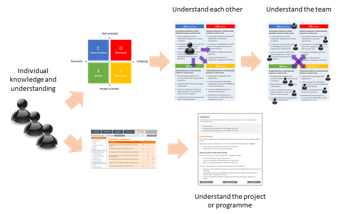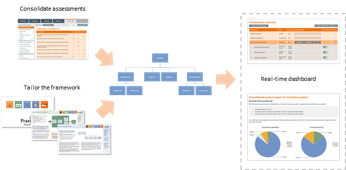Introduction
Click here to download a pdf brochure of the Praxis Pathway.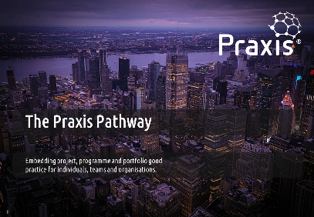
The world of project, programme and portfolio management is well served with guides, standards and models. The variety can be confusing, especially when trying to combine different publications to create an integrated model for project delivery1 as a whole.
This document introduces the Praxis Framework and describes how the Praxis Pathway utilises it to help organisations improve the effectiveness and efficiency of their project delivery by increasing individual performance, team effectiveness and organisational maturity.
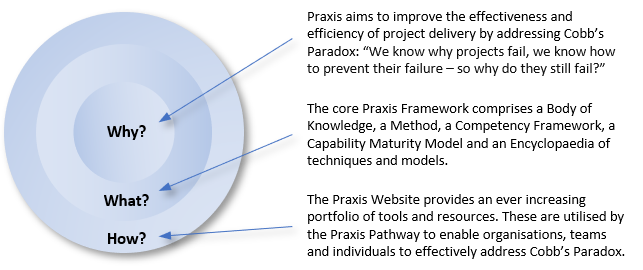
Why?
When Martin Cobb was CIO for the Secretariat of the Treasury Board of Canada in 1995, he asked the question that has become known as Cobb’s Paradox: “We know why projects fail, we know how to prevent their failure – so why do they still fail?”
At Praxis we believe this is primarily because organisations train people in good practice but do not provide them with the means to apply and embed that practice so that it becomes the natural way of doing things.
What?
In order to create a project delivery framework, organisations have to combine different guides, standards and resources. This involves harmonising terminology, removing overlaps and filling in gaps. It is a time consuming and expensive process, especially if the bespoke solution is not well maintained.
The Praxis Framework solves this problem by integrating an extensive Body of Knowledge2 with an established Methodical3 approach. It also provides a Competency Framework4 and Capability Maturity Model5 that are based on proven approaches and seamlessly integrated with the Knowledge and Method sections.
As with all Bodies of Knowledge and Methods, the framework makes frequent references to techniques and models that are regularly used in project delivery. These are all described in the Praxis Encyclopaedia.
How?
In order to promote and encourage the uptake and application of good practice, it must be readily accessible, comprehensive, regularly updated and simple to use. This is the purpose of the Praxis Website.
Individuals and organisations need processes and tools not only to gain knowledge and develop good practice but, more importantly, to support its adaptation and integration with organisational culture. The use of these processes and tools is what makes up the Praxis Pathway.
The Praxis Website
The Praxis Website is on-line and free at www.praxisframework.org. At its heart lies the framework of knowledge, method, competence and capability maturity - supported by the encyclopaedia of models and techniques. It also contains an ever increasing portfolio of resources provided by contributors from around the world.
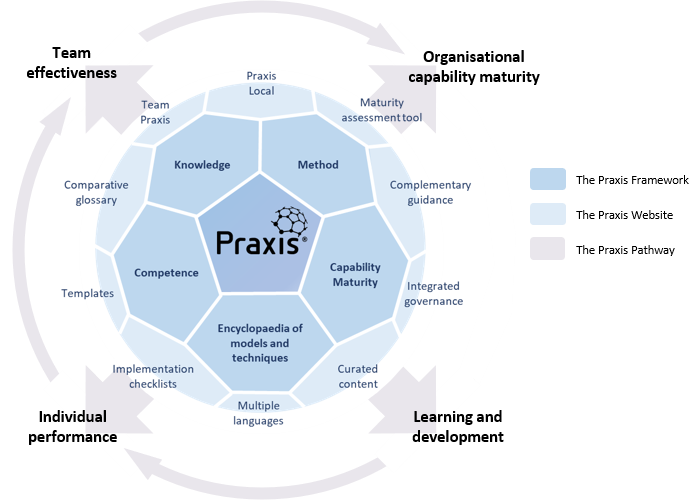
Other guides to project delivery provide information but then leave individuals and organisations with no support in implementing good practice. This is another area where Praxis is different.
The Praxis Pathway uses the contents of the Website and the Framework in particular, to demonstrate a means for an organisation to implement and embed good practice. Improvement is achieved organically and incrementally, making it easier and less expensive to achieve, more robust and less prone to failure.
The Praxis Pathway
The pathway has three component paths: individual, team and organisation. These paths are interwoven and collectively designed to achieve the central goal of improving the effectiveness and efficiency of project delivery.

Click on the diagrams below to see detailed information about each of the three paths:
Individual | |
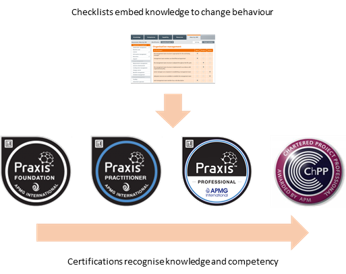 | The Individual Path provides a clear developmental route from basic knowledge to the peak of the profession. The first three certifications are awarded by APMG-International and these provide Route 2 exemptions for achieving Chartered Status, which is awarded by the Association of Project Management. |
Team | |
The Team Path has two branches. The first develops individuals' understanding of each others' preferences in applying the functions and processes of project delivery. The second establishes a common understanding about the effectiveness of the way a project or programme is being managed. | |
Organisation | |
The Organisation Path addresses the implementation of Praxis in combination with the organisation's own assets. provides a real-time dashboard of the organisation's progression towards higher levels of capability maturity. |
There are numerous guides and standards available for project, programme and portfolio management. They all include elements of well tested approaches but go no further than provide good practice in a limited area.
Praxis is unique in its comprehensive scope and full integration of all the elements of project delivery, including projects, programmes and portfolios. It is the only framework that provides a pathway for individuals, teams and organisations to develop effectiveness and efficiency in project delivery.
------------------------------------------------------
- ‘Project delivery’ is becoming an accepted term to collectively describe the management of projects, programmes and portfolios.
- The content of Praxis Body of Knowledge will be very familiar to users of the APM and PMI’s equivalent documents.
- All guides and standards follow the same fundamental governance life cycle. Praxis is no exception and users of methods such as PRINCE2 will quickly be able to identify with the Praxis approach, with the added benefit that the Praxis approach is applicable to both projects and programmes.
- The structure of the Praxis competency descriptions is based on the UK National Occupational Standards with both knowledge and performance elements.
- Carnegie Mellon University developed the definitive approach to Capability Maturity and the Praxis approach is based on the CMMI-Dev model.

